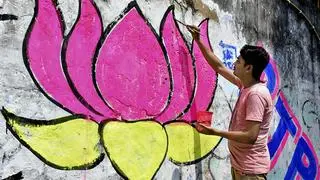Polling in Kerala on Friday seemed to peak on both sides of the noon-time lean phase forced by the oppressive heat as well as Friday noon prayers in segments with a significant Muslim population.
Analysts expect the final figure to reach the 2019 level when the Congress-led United Democratic Front (UDF) won hands down with a 19-1 margin.
Of the 20 seats, the UDF had won all but Alappuzha that went to Left Democratic Front (LDF) currently in power in the state. Forecasting elections is difficult in the ‘first past the post’ system’, an analyst said. A small swing in aggregate vote share can have massive repercussions on the number of seats a given party wins (or loses).
High turnout favours UDF
Received wisdom suggests high turnouts beyond 70 per cent benefit UDF. One need not go back beyond 2019 for proof. The Sabarimala factor and Rahul Gandhi’s candidacy in Wayanad ensured a turnout of 77.67 per cent, the highest in the last seven elections.
Turnout also picks up when anti-incumbency is evident. Perceived voter fatigue against the ruling LDF may ensure a final turnout figure on par with, if not beyond, what it was in 2019. A high turnout favours the UDF since incremental votes are basically non-LDF. In contrast, LDF votes are cadre-based votes and don’t go anywhere else. The LDF is seen to thrive when turnout is 70 per cent or below.
Post-Emergency surge
Kerala saw high turnouts in the post-Emergency elections of 1977 (79.2 per cent) and 1989 (79.03 per cent) when both favoured the Congress. In 1984, when elections were held shortly after the assassination of Indira Gandhi, the state recorded 77.13 per cent, with Congress winning 17 out of 20. In 2004, the voter turnout in Kerala was just 71.43 per cent when the LDF won 18.
But this year, straight two-cornered contests in some constituencies are matched by potential three-way races in others. Prestigious seats such as Thiruvananthapuram, Thrissur, Attingal, Palakkad and Vadakara took time to warm up but may throw up reasonably good numbers at the final count.
Cross-voting curse
Higher turnout also invites the poll-day curse of ‘cross voting’ which involves voting for a party one does not belong to. In a three-way race, a voter may decide to cross-vote to ensure victory for a candidate of rival party. This generates results that are against the ‘run of play.’ One needs to wait and see how results in closely fought seats, including Thiruvananthapuram and Thrissur, pan out.







